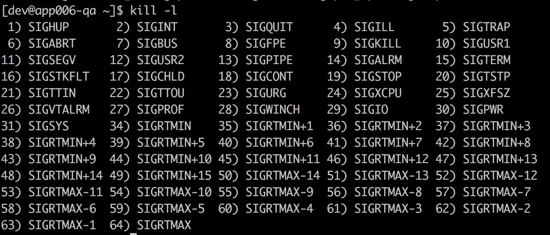常見Java應用如何優雅關閉
一、前言
在我們進行系統升級的時候,往往需要關閉我們的應用,然后重啟。在關閉應用前,我們希望做一些前置操作,比如關閉數據庫、redis連接,清理zookeeper的臨時節點,釋放分布式鎖,持久化緩存數據等等。
二、Linux的信號機制
在linux上,我們關閉進程主要是使用 kill 的方式。
當執行該命令以后,linux會向進程發送一個信號,進程收到以后之后,可以做一些清理工作。
kill 命令默認的信號值為 15 ,即 SIGTERM 信號。
通過 kill -l 查看linux支持哪些信號:
linux提供了 signal() api,可以將信號處理函數注冊上去:
- #include <signal.h>
- #include <stdio.h>
- #include <unistd.h>
- #include <stdlib.h>
- #include <stdbool.h>
- static void gracefulClose(int sig)
- {
- printf("執行清理工作\n");
- printf("JVM 已關閉\n");
- exit(0); //正常關閉
- }
- int main(int argc,char *argv[])
- {
- if(signal(SIGTERM,gracefulClose) == SIG_ERR)
- exit(-1);
- printf("JVM 已啟動\n");
- while(true)
- {
- // 執行工作
- sleep(1);
- }
- }
三、Java提供的Shutdown Hook
Java并不支持類似于linux的信號機制,但是提供了 Runtime.addShutdownHook(Thread hook) 的api。
在JVM關閉前,會并發執行各個Hook線程。
- public class ShutdownHook {
- public static void main(String[] args) throws InterruptedException {
- Runtime.getRuntime().addShutdownHook(new DbShutdownWork());
- System.out.println("JVM 已啟動");
- while(true){
- Thread.sleep(10L);
- }
- }
- static class DbShutdownWork extends Thread{
- public void run(){
- System.out.println("關閉數據庫連接");
- }
- }
- }
四、Spring Boot提供的優雅關閉功能
我們一般采用如下的方式,啟動一個Spring boot應用:
- public static void main(String[] args) throws Exception {
- SpringApplication.run(SampleController.class, args);
- }
SpringApplication.run()代碼如下,會調用到refreshContext(context)方法:
- public ConfigurableApplicationContext run(String... args) {
- StopWatch stopWatch = new StopWatch();
- stopWatch.start();
- ConfigurableApplicationContext context = null;
- FailureAnalyzers analyzers = null;
- configureHeadlessProperty();
- SpringApplicationRunListeners listeners = getRunListeners(args);
- listeners.started();
- try {
- ApplicationArguments applicationArguments = new DefaultApplicationArguments(
- args);
- ConfigurableEnvironment environment = prepareEnvironment(listeners,
- applicationArguments);
- Banner printedBanner = printBanner(environment);
- context = createApplicationContext();
- analyzers = new FailureAnalyzers(context);
- prepareContext(context, environment, listeners, applicationArguments,
- printedBanner);
- refreshContext(context);
- afterRefresh(context, applicationArguments);
- listeners.finished(context, null);
- stopWatch.stop();
- if (this.logStartupInfo) {
- new StartupInfoLogger(this.mainApplicationClass)
- .logStarted(getApplicationLog(), stopWatch);
- }
- return context;
- }
- catch (Throwable ex) {
- handleRunFailure(context, listeners, analyzers, ex);
- throw new IllegalStateException(ex);
- }
- }
refreshContext()方法比較簡單:
- private void refreshContext(ConfigurableApplicationContext context) {
- refresh(context); //調用ApplicationContext.refresh()
- if (this.registerShutdownHook) { //registerShutdownHook默認值為true
- try {
- context.registerShutdownHook();
- }
- catch (AccessControlException ex) {
- // Not allowed in some environments.
- }
- }
- }
AbstractApplicationContext.registerShutdownHook()代碼:
- public void registerShutdownHook() {
- if (this.shutdownHook == null) {
- this.shutdownHook = new Thread() {
- @Override
- public void run() {
- synchronized (startupShutdownMonitor) {
- doClose();
- }
- }
- };
- Runtime.getRuntime().addShutdownHook(this.shutdownHook);
- }
- }
很明顯,Spring boot通過在啟動時,向JVM注冊一個ShutdownHook,從而實現JVM關閉前,正常關閉Spring容器。而Spring在銷毀時,會依次調用bean的destroy動作來銷毀。
五、Dubbo的優雅關閉策略
Dubbo同樣是基于ShutdownHook實現的。
AbstractConfig的static代碼:
- static {
- Runtime.getRuntime().addShutdownHook(new Thread(new Runnable() {
- public void run() {
- if (logger.isInfoEnabled()) {
- logger.info("Run shutdown hook now.");
- }
- ProtocolConfig.destroyAll();
- }
- }, "DubboShutdownHook"));
- }
六、總結
只要我們的應用運行在linux平臺上,所有的優雅關閉方案都是基于linux提供的信號機制提供的,JVM也是如此。
Java并沒有為我們提供與之一一對應的api,而是給出了個ShutdownHook機制,也能達到類似的效果,缺點是我們無法得知JVM關閉的原因。
像dubbo、spring boot等成熟的開源框架,都實現了自動注冊ShutdownHook的功能,從而避免使用者忘記調用優雅關閉api引發問題,降低框架的使用難度。





































